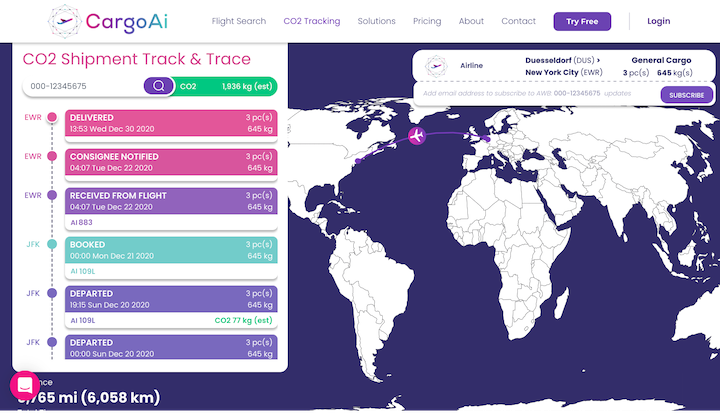CargoAi commits to greater sustainability in air cargo through unrivaled CO2 emission calculation features
Mar 24, 2021CargoAi is launching new features to allow freight forwarder to assess and reduce the CO2 emissions generated by their business activities. They can now choose routes and airlines based on their carbon impact and calculate the CO2 emitted from each shipment. Monthly CO2 emissions reports are also available to allow clients to analyse their own impact and monitor improvements.

Freight forwarders who want to take a sustainable approach can now do so thanks to new features from CargoAi. As powerful decision-making and CO2 emission calculation tools, these features are highly sought after by clients at a time when sustainability is playing an increasingly significant role in air cargo.
“Cargo stakeholders have really become aware of sustainability, and carbon impact is a recurring topic in discussions with our clients. Through these new features, we wanted to highlight the efforts that airlines are making to reduce their emissions by allowing forwarders to choose their carriers on that basis. It was essential for us to take a position on this issue and to innovate, because it’s also another way of thinking about air cargo differently,” said Matthieu Petot, CEO of CargoAi.
CargoAi’s unique Flight Search module now gives forwarders access to the CO2 emissions for each airline and route, allowing them to choose their transport solutions accordingly. Also, the free universal Track and Trace system enable any freight forwarder to track their shipment instead of checking with each airline and calculate at the same time the CO2 emission of the shipment. Finally, the monthly emissions report means forwarders can analyse their carbon impact and monitor improvements.
Several months of development work went into building this complex calculation system, with impartiality the primary goal. As a result, CO2 emissions calculations for all airlines are based on the IATA RP1678 methodology, which is approved by the Global Logistics Emissions Council (GLEC). The European standard DIN EN 16258 can also be used.
Similar Stories

American Airlines becomes only carrier to fly nonstop between Washington, D.C., and San Antonio
View ArticleOpen Skies agreement with the Dominican Republic enters into force
The U.S.-Dominican Republic Air Transport Agreement entered into force on December 19. This bilateral agreement establishes a modern civil aviation relationship with the Dominican Republic consistent with U.S. Open Skies…
View Article
WorldACD Weekly Air Cargo Trends (week 50) - 2024
View Article
Aeromexico now connects Miami with Cancun
View Article
EUROCONTROL Aviation long term outlook expects aviation to reach 15.4 million flights in 2050
View Article
Etihad Cargo adds Paris to freighter network with new weekly service
View ArticleGet the most up-to-date trending news!
SubscribeIndustry updates and weekly newsletter direct to your inbox!





